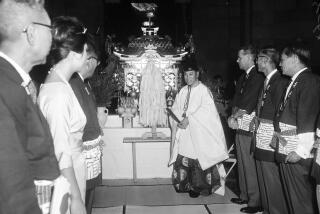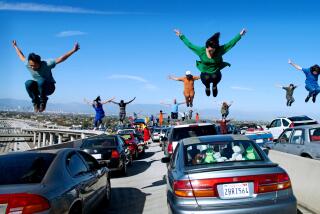In search of a monument that says ‘L.A.’
- Share via
The drudgery of the freeway commute is not eased by the sights along the way — the graffiti, the bad seat-belt poetry (“Click It or Ticket”), the seemingly endless number of billboards touting lap-band surgery.
Occasionally, it is true, there have been flashes of freeway culture.
Off-beat artist Sandra Tsing Loh performed a piano recital for motorists in a parking structure off the Harbor Freeway in 1987.
Singer Robert Goulet serenaded drivers with a megaphone from a helicopter above the Ventura Freeway in 1991 as part of a Valentine’s Day radio promotion. (One of his songs was “On a Clear Day You Can See Forever,” which seems out of place in Los Angeles.)
And more recently, artist Joel Kyack created “Superclogger,” a mobile puppet theater in which shows for stalled freeway travelers will be performed this summer out of the bed of a pickup truck.
But as writer Sharon Mizota recently observed in The Times, the freeway in Southern California is for the most part “an artistic wasteland.”
Civic leaders tried to remedy that situation in 1988 when Los Angeles Mayor Tom Bradley created a West Coast Gateway Committee to solicit designs for a cultural monument that would stretch across the Hollywood Freeway downtown.
It was seen as a symbol that might be to L.A. what the Statue of Liberty is to New York and the Eiffel Tower is to Paris.
Or, at least as the contest literature said, a structure that would make “the ride into and under the gateway … memorable.”
Cost of the landmark-to-be was put at $33 million, to be paid by private donors.
A design competition was financed by a $100,000 contribution from a Japanese company that hoped to construct the gateway.
More than 150 concepts were submitted to an international jury of artists and architects, and many were memorable, though not in the way that gateway backers might have preferred.
The entries included a giant baseball glove that would stretch across the freeway, a four-block-long dollar bill that would occupy a similar position and a transparent bird whose wings would extend from the Broadway off-ramp to the Alameda Street off-ramp while dropping an egg near Los Angeles Street.
Other concepts included a 400-foot-tall gold aluminum star (“akin to a lighthouse in the harbor”), 12 inflatable sculptures (the number inflated would indicate the hour of the day) and a nude man and woman holding up a globe.
French juror Roland Schweitzer told The Times the selection process would be difficult. Although Los Angeles has an identity, he said, “we don’t know exactly how to show this identity. We have to find it.”
Oddly enough, 10 of the 15 jurors were from foreign countries and several had never visited Los Angeles before, raising the question of how they could determine Los Angeles’ identity.
Perhaps the composition of the jury explains why the giant mitt was rejected: Few foreigners understand baseball.
Other ideas that were eliminated in the first round of the judging were the four-block-long dollar bill, the nude couple with the globe, the aluminum star and the inflatables.
But the egg-dropping bird survived. “There was a big fight about the bird,” admitted juror Sophia Zarabouka, a Greek artist. “But there is imagery to this for me.”
The winner, however, was “Steel Cloud” by New York architect Hani Rashid.
The Times described it as an “avant-garde series of geometrical metal shapes housing theaters, museum, cafes, walkways, a genealogy library and other cultural amenities … all growing out of the median strip of the Hollywood Freeway.”
The working model looked “as if it were built with an erector set.”
“Steel Cloud” might have charmed the jurors, but it did not fare as well in the court of public opinion.
Some likened the design to a freeway crash scene — or Los Angeles after the Big One.
Gloria Molina, then a councilwoman, commented, “It’s stressful just to look at the drawings.”
There were also concerns that it might stall traffic.
Times columnist Jack Smith wondered if it was a joke being played on L.A.
“The architect is a New Yorker,” he pointed out. “Ten of the 15 jurors who chose him are foreigners. How can we be sure it isn’t a Trojan horse?”
Rashid was not discouraged.
“We were hoping to get something that would cause a bit of excitement and exuberance,” he said.
He pointed out that many works “breaking new ground,” such as the Eiffel Tower, had been criticized at first but that “when those things are given the benefit of the doubt, they tend to prove themselves quite fantastic.”
But his project didn’t get the chance. The funding never materialized and “Steel Cloud” drifted out of memory.
In retrospect, the second-place finisher — the big bird — probably wouldn’t have received a warm welcome from the public either.
Imagine the jokes that would have been made about Los Angeles’ new landmark laying an egg.
More to Read
The biggest entertainment stories
Get our big stories about Hollywood, film, television, music, arts, culture and more right in your inbox as soon as they publish.
You may occasionally receive promotional content from the Los Angeles Times.










